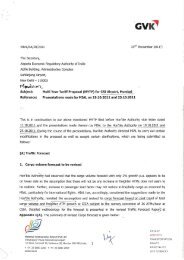Association of Private Airport Operators(APAO - AERA
Association of Private Airport Operators(APAO - AERA
Association of Private Airport Operators(APAO - AERA
You also want an ePaper? Increase the reach of your titles
YUMPU automatically turns print PDFs into web optimized ePapers that Google loves.
<strong>Association</strong> <strong>of</strong><strong>Private</strong> <strong>Airport</strong> <strong>Operators</strong><br />
Response 10 A EllA 's Consultatlon Paper No. 32/2011-12 til. 03 Jail 2012 0/1<br />
deterntiuation <strong>of</strong>Aeronautical Tarittin resoect onCI Alrnort, New Delhi<br />
3.15 The approach suggested by NIPFP underestimates the equity risk premium <strong>of</strong> the<br />
project. Aswath Damodaran mentions three approaches for calculating equity risk<br />
premium, when using developed market historical data <br />
a. Country Bond Default Spread (As used by NlPFP)<br />
b. Relative Equity Market Standard deviations<br />
c. Melded Approach (Bond Default Spread and Relative Standard Deviation)<br />
Aswath Damodaran recommends using the third approach for calculation <strong>of</strong> equity risk<br />
. d 7<br />
premium an says ,<br />
291/1 February 2012<br />
"The country default spreads provide an important first step in measuring country<br />
equity risk, but still only measure the premium for default risk. Intuitively, we would<br />
expect the country equity risk premium to be larger than the country default risk<br />
spread. To address the issue <strong>of</strong>how much higher, we look at the volatility <strong>of</strong>the equity<br />
market in a country relative to the volatility <strong>of</strong> the bond market used to estimate the<br />
spread. "<br />
"We believe that the larger country risk premiums that emerge from the last<br />
approach are the most realisticfor the immediate future ... "<br />
3.16 Aswath Damodaran also regularly calculates equity risk premium for different<br />
countries. Damodaran's current estimation <strong>of</strong> equity risk premium for India is 9.0%8.<br />
3.17 Risli Free Return: NIPFP in its methodology for calculating <strong>of</strong> equity risk premium<br />
has taken an arithmetic average <strong>of</strong> daily yield on 10-year Govenunent <strong>of</strong> India bonds<br />
resulting in a risk free return <strong>of</strong>7.35%. This risk free return is lower than the current 10<br />
year bond yield <strong>of</strong> 8.2%.<br />
3.18 Aswath Damodaran suggests taking the current risk free rate rather than a 'normal' risk<br />
free rate during valuations and says",<br />
"Interest rates generally change over time because <strong>of</strong> changes in the underlying<br />
fundamentals. Using a normal risk free rate, which is different from today's rate,<br />
without also adjusting the fundamentals that caused the current rate will result in<br />
inconsistent valuation. For example, assume that the risk free rate is low currently,<br />
because inflation has been unusually low and the economy is moribund. If risk free<br />
rates bounce back to normal levels, it will be either because inflation reverts back to<br />
historical norms or the economy strengthens. Analysts 'who use normal interest rates<br />
will then have to also use high er inflation and/or real growth numbers when valuing<br />
companies. "<br />
" 'Normal ' is in the eyes <strong>of</strong> the beholder, with different analysts making different<br />
judgments on what comprises that number. To provide a simple contrast, analysts who<br />
started working in the late 1980s in the United States, use higher normal rates than<br />
analysts who joined in 2002 or 2003, reflecting their different experiences. "<br />
7 Source: Equity Risk Premiums (ERP): Determinants, Estimation and Implications - The 20 II Edition, Aswath<br />
Damodaran, Stern School <strong>of</strong> Business, New York University<br />
8 Country Default Spreads and Risk Premiums, January 2012, Aswath Darnodaran, available at<br />
http://pages.stern.nyu.edu/- adamodarlNew_Horne_Page/dataf le/ctryprem.htmI<br />
9 Source: What is the riskfree rate? A Search Ior the Basic Building Block" Dec 2008 Aswath Damodaran, Stern School <strong>of</strong><br />
Business, New York University<br />
Page 13 or41
















